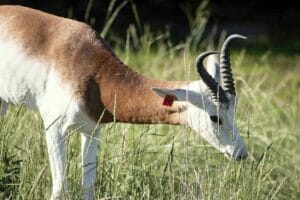
Appearance
Dama gazelle, also known as addra, are the largest of the gazelle species, and were formerly one of the most prevalent in Saharan Africa. Dama are mostly white, topped with an orangey-brown spot of hair that covers their neck and the majority of their back. Both males and females have short, curved horns, though the males are typically larger and thicker with 18-23 distinct rings.These gazelle, like many of their similarly sized relatives, can often be observed bouncing into the air with all four hooves off the ground at the same time. This behavior is called stotting.
Adaptations
The dama gazelle is diurnal and requires more water than its desert neighbors, although it can survive long periods of drought. Because of this, they can obtain most of their water from the plants they consume. Their diet includes various desert shrubs and acacias, along with rough desert grasses.
Dama are highly nomadic, constantly migrating in search of food and water. During the wet season, they migrate north to the Sahara. In the dry season, they return to the Sahel, or dry land of Africa, in their smaller groups.
Conservation
Extinct in much of its original range, the dama gazelle is now a critically endangered species. Today there are likely only around 100 wild individuals in Sudan and Chad. Humans have been a major cause of decline for this species, through a combination of illegal hunting, overgrazing by domestic cattle, and more. Even untouched dama habitat is at risk, having become more arid in recent years due to climate change.
In Chad, the scimitar-horned oryx reintroduction project has had a positive impact on the populations of gazelles living in the Ouadi Rimé-Ouadi Achim Wildlife Reserve since it was implemented there in 2016. Increased control of poachers and other environmental factors have helped as well, though there is still need for upgraded monitoring to understand how to better help this species.
Where are they?
Dama Gazelle live in the second pasture you enter. While the other antelope in this pasture are highly likely to be off to your right, there is a better chance these gazelle might have ventured over to your left as you drive through.
VIEWING TIPS
Especially when the grass in this pasture is not short, look low and you might see some dama gazelle heads near grass level when they are laying down. Or, like the other antelope in this pasture, look over to the right at the feeders.
Quick Facts
Scientific Name | Nanger dama |
Species Survival Plan | Yes |
Habitat | Desert, dry land |
Food | Acacia, bush leaves, herbs and grasses |
Originally Native To | Sahara and Sahel of Africa |
Characteristics | Antelope with bright white coat and reddish brown neck; S-shaped horns |
Lifespan | Wild 12 years |
Social Behavior | Herds of 10 - 20 |




